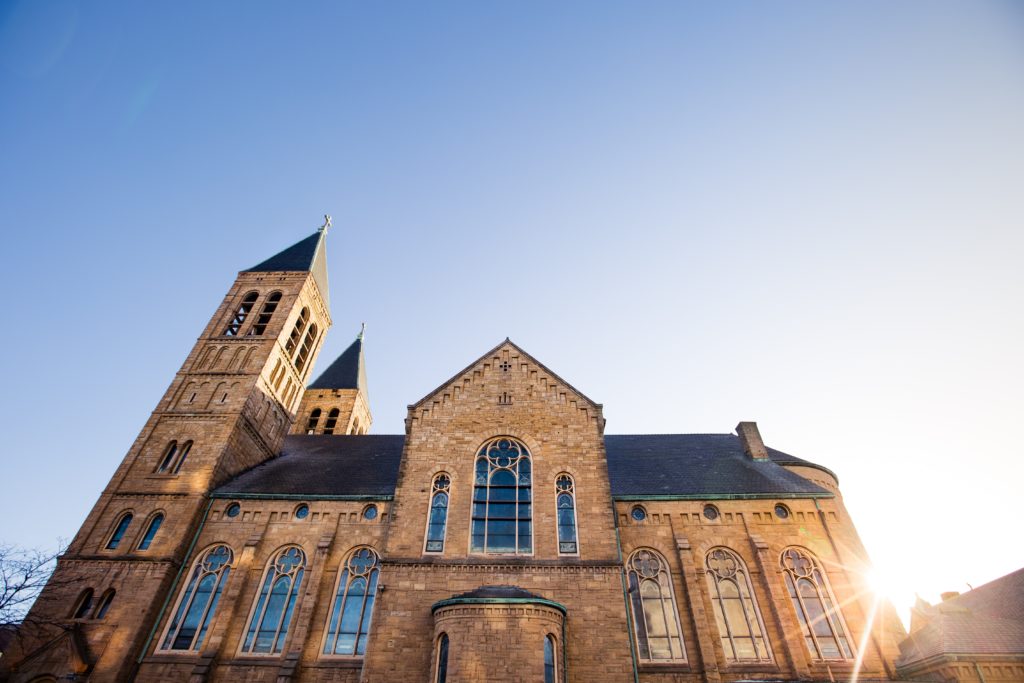In 494, in his effort to deal with the schism brought about by the monophysite heresy, Pope Gelasius wrote to the emperor Anastasius to urge him to conform his public witness to the teachings of his bishop. His letter has had a lasting impact on the Church’s understanding of the relationship of Church and state. It has become known as “Duo Sunt” for its famous formulation that “two there are, august emperors, by which this world is ruled.”
That formulation is hardly as simple as it is brief. The challenges of each age require a fresh revisiting of the relationship between those two powers that exercise legitimate authority in human affairs. In Gelasius’s time, it was taken for granted that the emperor had a role in modeling and shaping public practice of the faith. But it does not follow that recognition of two powers presumes that such a relationship is ideal, let alone normative. Rather, as has happened in the unfolding of history, the competence and proper domain of both powers have had to be liquidated in the course of social and political development.
Recent events in the United States and elsewhere—particularly the release of the Pennsylvania Attorney General’s report on sexual abuse and its systematic coverup by Church authorities—require us once again to consider the legitimate claims of these two powers to authority, and to consider their interdependence upon and rightful independence of one another.
When it comes to clerical sexual abuse, the primary question for the Church must be how best to keep children safe and deal justly with wrongdoers. Any question of the state’s role or the freedom of the Church is obviously secondary to the moral urgency of ensuring that children are kept safe. If and when abuse does occur, the response must be swift, compassionate toward victims, and ordered to justice and the prevention of any future such occurrence. Doing right by children and families is also essential to restoring trust in the institution(s) of the Church. That trust is not only crucial for a healthy Church internally, but also for the Church when it seeks to make claims for its independence and freedom.
Start your day with Public Discourse
Sign up and get our daily essays sent straight to your inbox.Yet with so many states now readying to follow the Pennsylvania model, many serious questions arise about the Church’s relationship to civil authorities. Why has the Church repeatedly required the press and the civil authorities to reveal facts that the faithful are entitled to know, and to force dubious expressions of contrition only after the fact? The Pennsylvania Attorney General’s report was not sprung upon the bishops as a surprise, and the Church’s own law has long considered clerical sexual abuse an offense of the utmost gravity. Yet there was no effort to lead the story with the Church’s own honest accounting, or even to provide the important context that nearly all the abuse in the report was in a sense “old news,” and that the problem of fresh relevance was the still inadequately addressed matter of episcopal nonfeasance and malfeasance. Our Church was already wounded by the initial instances and reports of abuse, and the faithful’s fragile confidence in her was shaken yet again.
Has Anything Really Changed Since 2002?
Many faithful Catholics have expressed the sentiment that recent events show that “nothing has changed.” In fact, some things have changed, for the better, although other urgent matters remain to be addressed.
Children are far safer in today’s Church, thanks to policies such as zero tolerance for those against whom charges of abuse have been substantiated, child protection education programs, and strict rules about church workers’ interaction with young people. While there is always the possibility of hidden abuse, today’s cautious new environment and highly protective rules, which have represented a sea change in the day-to-day life of the Church, have made children vastly safer from predators. That work of education and fine tuning will never end, particularly as new dangers arise in the age of electronic communication and social media. Still, the Church can rightly reassure parents that significant progress has been made.
At the same time, the November USCCB meeting in Baltimore highlights that there is still much work to be done. The Church must find ways to hold bishops accountable when they themselves have sinned either by committing abuse or by failing to appropriately address abuse committed by others.
At that meeting in Baltimore, as is now well known, the bishops were advised not to take action on a new policy for policing themselves until after a worldwide meeting at the Vatican in February. That may well be the most prudent course, both because the policies being considered by the USCCB were not necessarily composed with due deliberation and also because there is an argument to be made that a global standard should be set. But it cannot be denied that the unfolding of the news was unsettling. It appeared to take the USCCB by surprise, which the bishops made little effort to hide. Clearly, relationships among bishops are lamentably strained on these topics.
More Civil Investigations Are Justified
So where does this leave the faithful? It seems reasonable to surmise that the laity are going to be hoping for more, not less, civil intervention until there is persuasive evidence of transparency, genuine contrition for past sins, and firm resolve to avoid them in the future.
At least since 2002, the Church in the United States has accepted that criminal referrals where crimes have been credibly alleged are an absolute minimum when it comes to cooperation with the state. At the same time, as my colleague Rick Garnett has pointed out, the faithful should be wary of embracing innovations such as suspensions of statutes of limitations, which were not invented to deal with clerical sexual abuse and should not be jettisoned in haste when tempers are running high.
If two legitimate powers there be, the Church must respect the proper role of civil and criminal courts in policing the wrongs committed by her ministers. But she is not obliged to accept special treatment or scrutiny any more than she is specially entitled to escape just treatment or just scrutiny. The Church will be in no practical position to argue for its just treatment, however, if she does not make robust and visible progress in the months ahead to reassure both the faithful and the state that in her own exercise of authority the Church’s internal rules and procedures are ordered toward the well-being of her members and swift punishment of wrongdoing, as well as toward appropriate cooperation with civil authorities.
This process of reassurance should include a thorough accounting of well-known failures, such as the ascendancy and influence of Archbishop McCarrick. Many believe there was sufficient knowledge (or at least suspicion) of his wrongdoing to have dramatically altered the course of his ministry long ago. The faithful are likely to be merciful if there is transparency and contrition. They are rightly likely to remain skeptical so long as opacity remains the order of the day.
In Luke 19:44, Jesus wept over Jerusalem and her future because she did not recognize “the time of [her] visitation.” This crisis is an opportunity, an invitation to grace and repentance. Now is the time for the Church to contend deeply and thoroughly with the sins of our recent past and to build structures consistent with the call to holiness at the heart of the Church’s life. The first order of the day—today and every day—is our ongoing conversion as we seek more and more to share the mind of Christ. These sins of omission and commission are plainly far from the mind of one who offered a millstone to those who would lead his little ones astray. Any suggestion to the contrary makes a mockery of mercy and compassion. The Church owes all of us sinners hope and succor, but these do not entail ignoring their wrongdoing, lying to victims and their families, and permitting children to remain in peril at the hands of known offenders.
Now Is Not the Time To Give the Church More Temporal Power
Readers of Public Discourse will likely be aware that there is at present a separate but related discussion among Catholic thinkers in the United States about the relationship of the two powers in light of the arguable breakdown of the liberal order (as argued, for example, in Patrick Deneen’s Why Liberalism Failed). The question is asked whether in in a post-liberal order a new commitment to integralism is called for. Some, such as Adrian Vermeule, argue that the best reading of Gelasius and later Church teaching requires a commitment to a state whose laws favor the Church. It may be worth briefly noting that such debate strikes one as quite untimely unless and until the Church’s internal conversion advances further along the lines discussed above. As members of an institution that has sadly required and even more sadly resisted the proper intervention of the state to protect children from the worst sort of abuse, we are simply in no position to argue seriously for the abandonment of liberalism and the embrace of integralism. This is not to say that the crisis itself vindicates the liberal vision, merely that when the Church does not have her own house in order she is not well positioned to ponder let alone advocate ad extra for laws more favorable to her authority.
In fairness, however, to my friend Professor Vermeule and others, those of us who are skeptical of the integralist argument at this time should acknowledge that there are, even in the liberal West, varying models of cooperation and collaboration between Church and state. Indeed, even within the United States, the paradigm has shifted from one of a “wall of separation” to a more nuanced view of the Establishment Clause that is less paranoid of “entanglement” between Church and state. The approval of voucher schemes comes to mind. At the same time, the Supreme Court has robustly protected the freedom of the Church to govern her internal affairs in cases like Hosanna Tabor. But that very shifting picture reminds us that these settlements are tenuous and responsive to changes in the Church and the civil polity, and that history does not move smoothly in one direction called “progress.”
Advent is now upon us, inviting us to ponder our mortality as well as the horizon of eternal life, and inviting us to be watchful for the coming of our Savior. He is at the gates, and our time of visitation has arrived. In Luke’s account, just before Jesus weeps over Jerusalem, he encounters the tax collector Zacchaeus curiously observing him from a perch in a tree: “Zacchaeus, come down quickly, for today I must stay at your house.” May the Church in this season of conversion find the humble enthusiasm of Zacchaeus to recognize this time of visitation.














